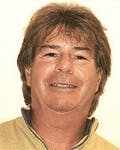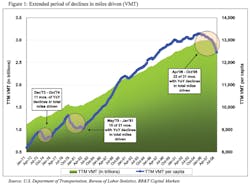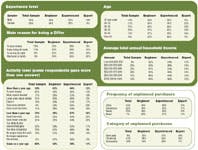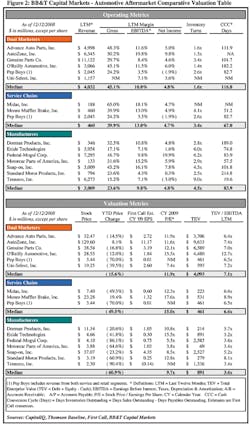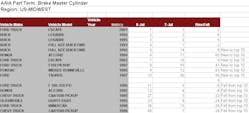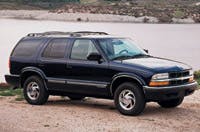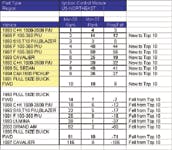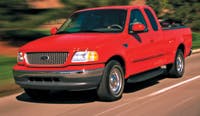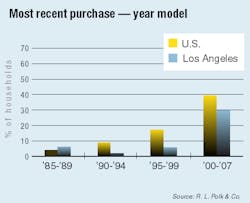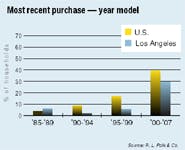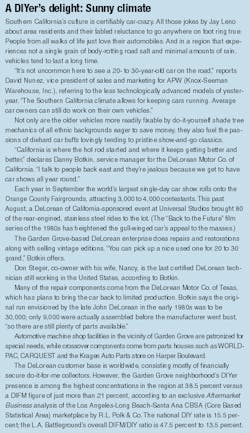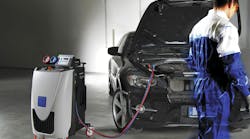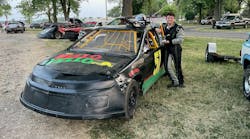Located in St. Paul, Minn., Latuff Brothers Auto Body is pretty far from sunny Southern California. But for Latuff, there were plenty of good reasons to voluntarily make the switch. Latuff has been spraying 100-percent waterborne basecoat for more than two years. He first learned about the changing technology from a member of his 20 Group. "He was shooting it for about three years, and he had no problems with it," recalls Latuff. "His cycle time was better and his production went up."
The use of waterborne paint has grown in Europe as a result of changing environmental regulations and the same law changes will soon impact the U.S. and Canada. In California's South Coast Air Quality Management District (which includes the Los Angeles area), some 1,800 collision shops will need to make the switch to waterborne beginning in July 2008.
In addition to California, waterborne is being used at shops in Florida, Texas, Virginia, Massachusetts, Minnesota and all points in between. OEMs overseas and increasingly in the U.S. are also using it.Unlike Latuff, many shop owners and painters are dubious about waterborne. The paint takes much longer to dry than solvent-based products, and could require a significant investment in new equipment and training. Experts expect a decline in the number of shops as a result of the new rules, perhaps as much as 20 percent to 30 percent.
The California Air Resources Board (CARB), in its original analysis discussing the impact of tightening the VOC restrictions, estimated that repair facilities would see an average decline in profitability of 15 percent because of the increased costs. However, CARB predicted the bulk of those costs would be passed on to customers.
Equipment investment estimates have been all over the map, from less than $1,000 to more than $100,000. The problem with these estimates is that equipment needs will vary by shop, by the type of paint being used, and by regional climate. And right now, there just aren't that many repairers using waterborne, even in California.So far, most shops that have already made the conversion are giving the paint positive reviews, from both a quality and profit standpoint.
"You can produce about two cars a day more per booth with waterborne than solvent-based paints," says Latuff. "It's been a real plus for us."
Equipment investment
Latuff Brothers has one 15,000-sq.-ft. location in St. Paul, and handles an average of 175 cars per month. According to Latuff, the company invested about $60,000 between two paint booths, and eliminated a third booth. "When we went to water, we dropped from three to two booths, and we're now doing more cars with two booths than we did with three," he says.Latuff is using DuPont's Spies Hecker waterborne paint. The bulk of the equipment investment was in a new air movement system.
"When you look at the whole picture, we've lowered our VOCs by 58 percent, increased throughput, cut back on gas usage in the booths per cycle time, and all that translates to dollars on the bottom line," Latuff says. "People are also becoming more aware of the greenhouse gases and the affect of VOCs, so there has been some good reaction from the public as well."Clair Collision Center in West Roxbury, Mass., was an early adopter of the Spies Hecker paint, and served as a testing location back in 1997. "It worked pretty well, and we got hooked," says John Assini, general manager at Clair. Right now, about 90 percent of the work done at Clair is with waterborne. The shop still uses some solvent-based paints in the prep deck for cutting in parts.
Clair works primarily on high-end cars, and averages around 360 vehicles a month. Waterborne has helped boost throughput. "We can get one more car a day out of each booth, because there's less flash time," Assini says.Assini used portable dryers at the shop's old location. At Clair's new 30,000-sq.-ft. facility, three spray booths are outfitted with high air movement systems, and a fourth has Junair's QADS system. The shop also uses stainless steel paint guns. "We use the same guns as when we started," says Assini. "We just had to change some of the adapters."
"We pretty much walked right in and started spraying with what we had," says Latuff. "We changed some of the needles in the guns, based on the personal preference of the painter, but that was it."Autobody Masters in Culver City, Calif., has only been up and running with waterborne since January. The 36,000-sq.-ft. shop has two spray booths and averages 200 to 250 cars per month. Owner Jeremy Baltzer says the shop spent approximately $100,000 on new equipment when it switched to BASF's waterborne system. Their downdraft booths were equipped with a new Junair circulation system, and their older spray guns were replaced with newer, stainless steel models.
"We replaced our compressor with one that has a better dryer for getting dryer and more clean air," Baltzer says. "You really need perfect air coming through those guns."
Keith Brown at Auto Color Co. Inc., a Georgia-based distributor, says a lot of shops don't worry about the quality of their air, and as a result, the compressors are not as dry as they should be. "If you have real wet air coming through the compressor, that's going to affect the finish," says Brown.Although some of the shops interviewed for this story did not buy new spray guns, most manufacturers and jobbers recommend that repairers use newer stainless steel guns to prevent rusting. Other jobbers and shop owners, though, contend existing guns will work fine, but will need to be cleaned carefully to prevent corrosion.
The biggest equipment changes will be in air circulation. Without the proper air movement, waterborne paint takes longer to dry.
Built-in drying equipment will be more efficient, and many shops are using downdraft or crossdraft booths. For lower volume shops, portable drying units could also work (and are less expensive). In more humid regions, like the Southeast or in Louisiana, Mississippi and other southern locales, expect lengthy drying periods even with a lot of air, particularly in the summer.Air is more important than heat, although heat can help speed the dry time. Heat lamps used without sufficient air movement, however, can actually slow drying by creating moisture near the surface of the refinished areas.
Eckles Auto Body in Whittier, Calif., has invested in new SATA stainless steel guns, but for now the shop is using portable dryers (both hand-held and on wheels) in their two downdraft spray booths. The shop, which works on approximately 100 to 120 cars per month, began using waterborne paint in December, and has served as an early test location for PPG.According to owner Carlos Sacchetto, Eckles is taking a phased approach to waterborne, and is using the paint on about 50 percent of their jobs. He's currently looking at some different air moving equipment for the booths to speed up the dry time.
"My advice to shop owners is to not be scared about this," Sacchetto says. "The change is not as critical as people are making it out to be. You can get away with portable dryers until you get acquainted with the material."Pride Auto Body's Van Nuys, Calif., shop (one of six in the region) is serving as a beta site for Akzo Nobel's Sikkens waterborne paint. According to paint department Manager Paco Arias, the company has invested approximately $4,000 in new guns and new fans from Garmat for two spray booths. The fans have helped keep the flash times consistent with what the shop experienced with solvents (just a few minutes between coats).
"I recommend going to the paint manufacturer's training center, and checking on the their recommendations for drying the basecoat," says Arias. "You don't have to spend too much money to dry the basecoat. The ceiling fans we put in work perfectly."Assini says with the amount of air that Clair Collision is using, the shop averages five to seven minutes between the application of the base and clear. In the summer, when it is more humid, they sometimes have to bake the paint so that the moisture will evaporate more quickly.
There are also new types of paper and tape being released that are optimized for waterborne applications, but many shops have had good results using standard materials.
"We've been using regular 3M papers, and we've been doing okay," Sacchetto says. "The problem with waterborne is it can run if it lays on the paper. They are coming out with new materials with a sort-of wax coating on it that absorbs the moisture. We're checking out some of those papers, but that will be an inexpensive change."Proper storage
Because these products contain water, shops that experience freezing temperatures during the winter need to make sure that waterborne paint is kept off the ground, and that product stored for any length of time in the shop be kept warm enough to prevent freezing.
Waterborne paints come in smaller can sizes (one liter or half-liter), so shops should cycle through the inventory fast enough to avoid storage issues. Some of the paint manufacturers are offering heated cabinets for shops in colder climates."Storage is more of a logistics problem for the jobbers and manufacturers," says Latuff. "As long as you keep it indoors and it doesn't get below freezing, you should be okay."
Baltzer says his shop hasn't had any temperature problems with the new paint. "Back in January, we were below 30 degrees," he says. "There was ice all over the shop, and we had no problem with the paint. We're next to the beach, so we have cold days; we have hot days. We've had no viscosity problems whatsoever."
Training
Spraying waterborne paint does require some adjustment for the painters, but most shops have made the transition fairly smoothly. The biggest difference in the application is that waterborne requires fewer coats than solvent-based paint, and takes longer to dry.
"The steps are all the same as far as applying it," says Danny Dillard, body shop manager and painter for Richard Childress Racing. The Childress team has been using waterborne at its paint shop near Winston-Salem, N.C., for several months "As far as spraying overall, I can't tell any difference. I've not had any trouble with it."
Childress made the switch to Sherwin-Williams' AWX product last summer, and debuted the paint on the RCR No. 29 car at the California Speedway. According to Dillard, the Childress shop didn't have to make any major equipment adjustments.
Latuff Brothers had to do most of its training on the job, since there wasn't much of a push behind water-based products when they started.
"There is a little bit of learning curve," Latuff says. "One thing I would tell people is you can't do a two-week trial with water. When we did it, we told painters what they would gain as far as the health benefits and the quality of the paint. They bought into the program. We went forward with it. One day we just stopped having solvents, and the next day we had waterborne."
Pride Auto Body sent its paint crew to Akzo Nobel's training center during the conversion of its 300-car-per-month facility in Van Nuys. Akzo Nobel also provided in-shop technical support.
"We experimented with different spraying techniques, and we came to the conclusion that there is not much difference in spraying waterborne versus solvent," says Arias. "You have to clean the guns with a different solvent, but that's the only major difference. Our painters took to it very quickly. One painter had only been painting for eight months when we switched, and he had no problems at all."
Starting in May, Pride will convert the remainder of its locations over about a three-month span.
Autobody Masters worked closely with its local jobber and BASF to make the switch. "They stuck with us and showed us all the different procedures involved with spraying it, and built our confidence in the paint," Baltzer says. "This was the easiest transition I've been through. I was expecting a lot worse."
At Eckles Auto Body, painter Filibero Vasquez was an enthusiastic proponent of waterborne once he started working with it. Because Eckles is using portable blowers, their waterborne jobs do take a little longer, but Sacchetto thinks the benefits outweigh the costs overall.
"The quality of the paint is the same, but you use less paint," says Vasquez. "The jobs take a little longer because we are manually blow drying, but other than that it is pretty much the same."
Because some experienced painters are resistant to making the switch to waterborne, Assini has worked primarily with new painters at Clair. "We train our own painters here. The only thing they know how to spray is waterborne," he says.
Jobbers and paint manufacturers have stepped up their outreach efforts in California, where collision shops are closing in on the deadline for the new VOC rules. Most are offering on-site support as well.
Fewer coats, richer color
Even shops that aren't facing regulatory requirements could benefit from using waterborne paints. Although they can be more expensive than solvent, waterborne provides better coverage with fewer coats.
"The coverage is much better," says Latuff. "What you'd normally cover in solvent with four or five coats, you can do one or two coats with water. You're not putting as much material down, so there's not as much shrinkage or dying back issues as you have with solvent. There are a lot more pluses than minuses."
Latuff likes the fact that the finish doesn't mottle, and tends to be less cloudy than with solvents. Color match, metallic control and the ability to blend can also exceed the performance of solvent-based coatings.
Both Latuff and Assini reported increased throughput at their shops. At Autobody Masters, which has only been using the paint for a few months, there hasn't been a noticeable change yet. "We might be able to squeeze out a half or full vehicle more per day," Baltzer says. "The biggest thing is, it hasn't disrupted production at all, or slowed us down." Baltzer also likes the fact that colors tend be "a lot more brilliant. That's the best way to describe it," he says.
Adds Sacchetto at Eckles, "I like the way the waterborne lays on the bumpers. The color match on plastic is better."
Sacchetto says some models have been easier to match than others. "BMW is spraying waterborne, so it's easy to match those. We do all waterborne on Mercedes, and we have no problem matching Volkswagens," he says. "For other vehicles, it might take a little longer to figure it out. This is new to us and new to everybody, but by having this experience ahead of time, we're able to play with the paint and see what works best."
Water-based paints have an obvious environmental advantage over solvents, which in some areas can serve as a good marketing tool and help improve community relations. Waterborne also reduces waste, which can impact profitability.
"We've cut our waste bill by around two thirds," says Assini at Clair. "We actually went from being a large waste generator to a small waste generator, and we don't have to worry about recycling as much material."
There's a reduced risk of fire, and employees won't be breathing in as many fumes. "It really does smell different," says Allard. "That's the one thing different that I've really noticed is the odor."
"There are no explosion-proof cabinets, because it's water-based," says Sacchetto. "And there are fewer toners in your cabinets now, because the paint mixes differently. You just shake it and pour it."
California shops will be under pressure to get rid of any remaining solvent-based product. According to Baltzer, Autobody Masters was able to run through most of its solvent-based paint before the conversion. The jobber and paint supplier helped, as well.
"The unopened stuff we were able to return, and we got credit back," Baltzer says. "You have plenty of time to use up the stuff you can't get refunded on."
Get started
For California shops, time is running out to begin the conversion process, even though many of the paint manufacturers have not yet released their full product lines. Shops should get started now, so they have plenty of time to get used to the paint and dispose of their solvent-based product before enforcement begins.
"Do your homework, and pay attention," Baltzer says. "We took two years and investigated a lot of products. I know how disruptive it is to make a change like this. The transition within our shop went really smoothly."
And even though waterborne paints might cost more, there are plenty of benefits that can offset the additional investment in equipment.
"I think waterborne paint is a better way to go," says Todd D'Angelo of distributor D'Angelo's Automotive & Industrial Coatings in California. "Most of the OEM finishes are waterborne now, and the color matches are a lot better. This is a way you can save money, be more environmentally friendly, and get better color matching."
Shops in other parts of the country should also investigate waterborne.
"As soon as the legislation goes through in California, we're going to see it here," says Assini. "Massachusetts generally follows what California does."

